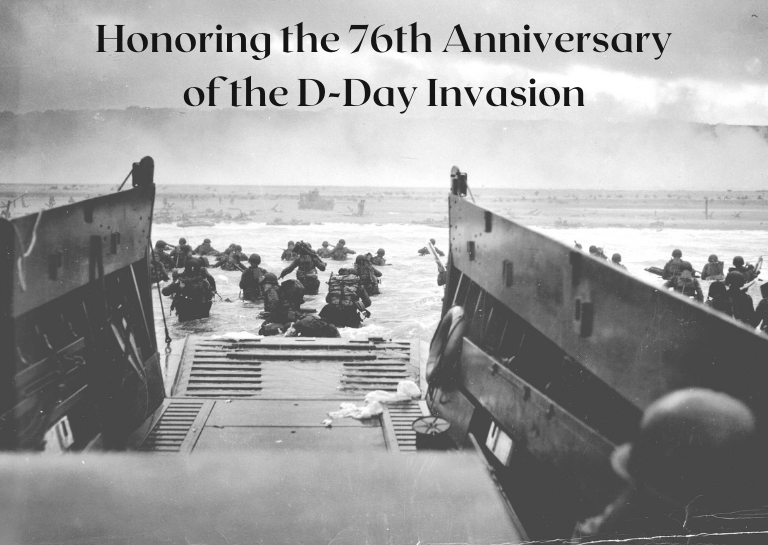
10 Facts About the D-Day Invasion You Need to Know
D-Day is recognized as a major turning point of World War II. This year, we honor the 76th anniversary of the D-Day invasion with a little D-Day history and some interesting facts you may now know about one of the most notorious events in the history of modern warfare.
What is D-Day?
Operation Overlord, the Allied invasion of Nazi-occupied France via the English Channel and beaches of Normandy, is one of the most notorious and important operations in Military History. Landing on those beaches – the D-Day Invasion – was a massive, uniquely coordinated attack, that turned the tides of the war in favor of the Allies.
Why is it Called D-Day?
Interestingly, there really isn’t any significant “D-Day” meaning as it relates to the Normandy Beach invasion. D-day was simply the term used to indicate the launch date of a mission before the actual date was chosen. Once a date was chosen, the term D-Day was used to keep it a secret from the enemy. As it turns out, this particular mission altered the course of history, and we continue to refer to Allied troops storming the beaches of Normandy as “D-Day.”
When Was the D-Day Invasion?
While the D-Day Invasion was scheduled to take place on June 5, 1944, bad weather forced a delay. When forecasts showed a brief window of clear weather the next morning, the decision was made to move forward with the mission.
Around midnight on June 6th, airborne troops were dropped behind enemy lines, inland from the coastline and beaches of Normandy. Their mission was to sabotage bridges, railroad lines, and any other thoroughfare which could be used to provide reinforcements to the Germans once the attack was underway.
Despite the rough waters, the D-Day Invasion took place just after dawn the same day, and one of the bloodiest battles of the war was underway. Germans had previously lined the Normandy landing zone with a wall of obstacles making amphibious invasion incredibly difficult, and the day wasn’t without significant loss. Nearly 4,500 Allied soldiers lost their lives during the Normandy invasion; however, by nightfall, roughly 140,000 Allied troops had successfully made it ashore.
The Impact of D-Day on WW2
The D-Day invasion created the opportunity for Allies to set up shop in Nazi-occupied Europe, and the German Army began to retreat. Additional offensives to advance inland were underway within three months of D-Day.
Less than a year later, Germany formally surrendered to the Allies and victory was declared in Europe. This date, May 8th, continues to be celebrated today as V-E (Victory in Europe) Day.
On September 2, 1945, World War II officially ended with the surrender of Japan. This date is known as V-J (Victory over Japan) Day.
10 Interesting Facts About D-Day
- Churchill began speaking of the invasion of Europe in October of 1941, and planning for Operation Overlord to begin roughly 6 months later.
- Allied forces created a fuel pipeline beneath the waters of the English Channel which serviced vessels and vehicles both before and after the D-Day invasion.
- Allied undercover agents posing as Nazi sympathizers purposely “tipped off” the German High Command about an impending invasion in the Pas de Calais region of France – the area of French coastline closest to Brittan. The decoy worked as hoped, and Hitler flooded the wrong area with Nazi troops waiting for a battle that never came.
- A convoy of fake tanks and inflatable trucks were set up as decoys near Pas de Calais to further the ruse that an invasion was headed in that direction.
- The deception campaign was so successful that even after the D-Day invasion was underway, Hitler believed it was a decoy. He refused to send backup to the beaches of Normandy, for fear of the “real” invasion he was sure would occur in Pas de Calais.
- Nearly 350,000 members of the French Resistance helped the Allies prepare for D-Day.
- Prior to the invasion, the Allies constructed two temporary harbors, which were then sent to Normandy on the heels of Allied troops. After the battle was won the harbors provided allies the ability to unload roughly 2.5 million men, 500,000 vehicles, and over 4 million tons of supplies through the end of the. war.
- The weather was so bad leading up to D-Day that the German Commander in Normandy was convinced there was no chance of an invasion on the day. So, he left his post and headed home just prior to the landing to give his wife a birthday present.
- Built by the Germans to defend against an amphibious landing like the D-Day invasion, the Atlantic Wall spanned 2400 miles of French coastline. It included thousands of concrete bunkers stocked with artillery, tens of thousands of tank ditches, and 6.5 million land mines, among other obstacles.
- Twelve allied nations participated in the invasion of Normandy: America, Brittan, Canada, Australia, Belgium, Czechoslovakia, Holland, France, Greece, New Zealand, Norway, Rhodesia, and Poland.
Further Reading
For more D-Day history and interesting facts about the D-Day invasion and other important points during WWII, visit www.iwm.org.uk.
 https://militaryconnection.com/wp-content/uploads/Month-of-the-Military-Child.png
545
768
lauren
https://militaryconnection.com/wp-content/uploads/2018/09/mc-logo2.png
lauren2022-04-14 14:34:572023-02-28 12:26:35Celebrating Month of the Military Child 2022
https://militaryconnection.com/wp-content/uploads/Month-of-the-Military-Child.png
545
768
lauren
https://militaryconnection.com/wp-content/uploads/2018/09/mc-logo2.png
lauren2022-04-14 14:34:572023-02-28 12:26:35Celebrating Month of the Military Child 2022





















